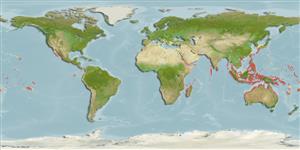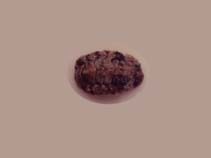Acanthopleura gemmata (de Blainville, 1825)
Northern spined chiton| Native range | All suitable habitat | Point map | Year 2050 |

|
| This map was computer-generated and has not yet been reviewed. |
| Acanthopleura gemmata AquaMaps Data sources: GBIF OBIS |
Classification / Names Common names | Synonyms | CoL | ITIS | WoRMS
Polyplacophora | Chitonida | Chitonidae
Environment: milieu / climate zone / depth range / distribution range Ecology
Benthic; depth range 0 - 2 m (Ref. 1456). Tropical
Distribution Countries | FAO areas | Ecosystems | Occurrences | Introductions
Indo-Pacific.
Length at first maturity / Size / Weight / Age
Maturity: Lm 1.4, range 1 - 1.8 cm Max length : 12.0 cm TL male/unsexed; (Ref. 85382)
Minimum depth assumed from its ecology. Inhabits fringing barrier reef (Ref. 2912). Found in mangrove areas (Ref. 2908). Algae-feeding herbivore (Ref. 1456). Uses its radula to excavate a home site for grazing surface algae (Ref. 2907). Occurs at the high tide mark. Found from intertidal to 2 m, on rocks (Ref. 75835).
Life cycle and mating behavior Maturity | Reproduction | Spawning | Eggs | Fecundity | Larvae
Members of the class Polyplacophora are gonochoric. No copulation; males release sperm throught their respiratory currents and females shed the eggs into the sea. Eggs develop into lecithotrophic planktonic trochophore (Ref. 833). First reproduction occurs when individuals have reached the age of two (years) (Ref. 94892). In the Red Sea, spawning occurs during autumn (Ref. 98877).
Main reference
References | Coordinator | Collaborators
Dell'Angelo, B., A. Bonfitto, M. Taviani and B. Sabelli. 2003. (Ref. 703)
IUCN Red List Status (Ref. 130435)
CITES status (Ref. 108899)
Not Evaluated
CMS (Ref. 116361)
Not Evaluated
Threat to humans
Harmless
Human uses
Fisheries: commercial
| FishSource | Sea Around Us
Tools
More information
Internet sources
BHL | BOLD Systems | CISTI | DiscoverLife | FAO(Publication : search) | Fishipedia | GenBank (genome, nucleotide) | GloBI | Gomexsi | Google Books | Google Scholar | Google | PubMed | Tree of Life | Wikipedia (Go, Search) | Zoological Record
Estimates based on models
Preferred temperature
(Ref. 115969): 24.5 - 29.3, mean 28.4 (based on 2511 cells).
Price category
(Ref. 80766):
Unknown.
Nutrients: Calcium = 126 [75, 177] mg/100g; Iron = 4.79 [1.67, 7.92] mg/100g; Protein = 16.6 [15.4, 17.8] %; Omega3 = 0.331 [0.263, 0.400] g/100g; Selenium = 57.8 [48.5, 67.2] μg/100g; VitaminA = 0 μg/100g; Zinc = 1.97 [0.92, 3.02] mg/100g (wet weight).



